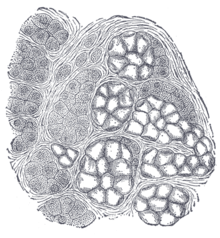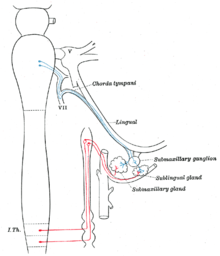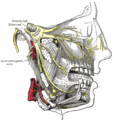- Submandibular gland
-
Submandibular gland 
Salivary glands:
1 - parotid gland,
2 - submandibular gland,
3 - sublingual glandLatin glandula submandibularis Artery glandular branches of facial artery Nerve submandibular ganglion MeSH Submandibular+Gland The paired submandibular glands (submaxillary glands) are salivary glands located beneath the floor of the mouth. In humans, they account for 70% of the salivary volume and weigh about 15 grams. Unstimulated (at rest) in humans, the percentage contribution to whole saliva; ~25% Parotid, Submandibular and Sublingual ~ 67% and ~8% minor mucous glands. During stimulated secretion the parotid gland produces majority of the saliva.
Contents
Anatomy
Lying superior to the digastric muscles, each submandibular gland is divided into superficial and deep lobes, which are separated by the mylohyoid muscle:
- The deep portion is the smaller portion. The mylohyoid muscle runs below it.
- The superficial portion comprises most of the gland.
Secretions are delivered into the Wharton's ducts on the deep portion after which they hook around the posterior edge of the mylohyoid muscle and proceed on the superior surface laterally. The ducts are then crossed by the lingual nerve, and ultimately drain into the sublingual caruncles on either side of the lingual frenulum along with the major sublingual duct (Bartholin).
Histology
Lobes contain smaller lobules, which contain adenomeres, the secretory units of the gland. Each adenomere contains one or more acini, or alveoli, which are small clusters of cells that secrete their products into a duct. The acini of each adenomere are composed of either serous or mucous cells, with serous adenomeres predominating. Some mucous adenomeres may also be capped with a serous demilune, a layer of lysozyme-secreting serous cells resembling a half moon.
Like other exocrine glands, the submandibular gland can be classified by the microscopic anatomy of its secretory cells and how they are arranged. Because the glands are branched, and because the tubules forming the branches contain secretory cells, submandibular glands are classified as branched tubuloacinar glands. Further, because the secretory cells are of both serous and mucous types, the submandibular gland is a mixed gland, though it is mostly serous.
Functions
The secretory viscous cells of the submandibular gland have distinct functions. The mucous cells are the most active and therefore the major product of the submandibular glands is saliva. In particular, the serous cells produce salivary amylase, which aids in the breakdown of starches in the mouth. Mucous cells secrete mucin which aids in the lubrication of the food bolus as it travels through the esophagus.
The submandibular gland's highly active acini account for approximately 70% of salivary volume. The parotid and sublingual glands account for the remaining 30%.
Innervation
Their secretions, like the secretions of other salivary glands, are regulated directly by the parasympathetic nervous system and indirectly by the sympathetic nervous system.
- Parasympathetic innervation to the submandibular glands is provided by the superior salivatory nucleus via the chorda tympani, a branch of the facial nerve that synapses in the submandibular ganglion after which it follows the Lingual nerve leaving this nerve as it approaches the gland. Increased parasympathetic activity promotes the secretion of saliva.
- The sympathetic nervous system regulates submandibular secretions through vasoconstriction of the arteries that supply it. Increased sympathetic activity reduces glandular bloodflow, thereby decreasing salivary secretions and producing an enzyme rich mucous saliva.
Pathology
The submandibular gland accounts for 80% of all salivary duct calculi, possibly due to the different nature of the saliva that it produces and that its duct is up-sloping.
Additional images
References
- Douglas F. Paulsen (2000). Histology and cell biology (4th edition ed.). Stamford, Conn: Lange Medical Books/McGraw Hill. ISBN 0-8385-0593-7.
- A. R. Ten Cate (1998). Oral Histology: Development, Structure, and Function (5th edition ed.). Saint Louis: Mosby-Year Book.
External links
- Histology at usc.edu
- submandibular+gland at eMedicine Dictionary
- SUNY Labs 25:10-0109 - "Anterior Triangle of the Neck: Nerves and Vessels of the Carotid Triangle"
- SUNY Labs 34:09-0102 - "Oral Cavity: The Submandibular Gland and Duct"
- cranialnerves at The Anatomy Lesson by Wesley Norman (Georgetown University) (VII)
Head and neck anatomy, digestive system: Mouth anatomy (TA A05.1–2, TH H3.04.01, GA 11.1110–2, 1125–1141) Mouth Lip (Upper, Lower, Vermilion border, Frenulum of lower lip, Labial commissure of mouth, Philtrum)
Cheek (Buccal fat pad)Interdental papilla · Gingival sulcus · Gingival margin · Free gingival margin · Gingival fibers · Junctional epithelium · Mucogingival junction · Sulcular epithelium · Stippling
Periodontium: Cementum · Gingiva · Periodontal ligamentParotid gland/Parotid duct · Submandibular gland/Submandibular duct · Sublingual gland/Major sublingual ductTeethsee tooth anatomydorsum (Taste bud, Median sulcus, Terminal sulcus, Foramen cecum, Lingual tonsils) · underside (Frenulum, Fimbriated fold, Sublingual caruncle) · Anterior · Posterior · Glossoepiglottic folds · Lingual septumOro-pharynx/
faucesCategories:- Glands of mouth
Wikimedia Foundation. 2010.






